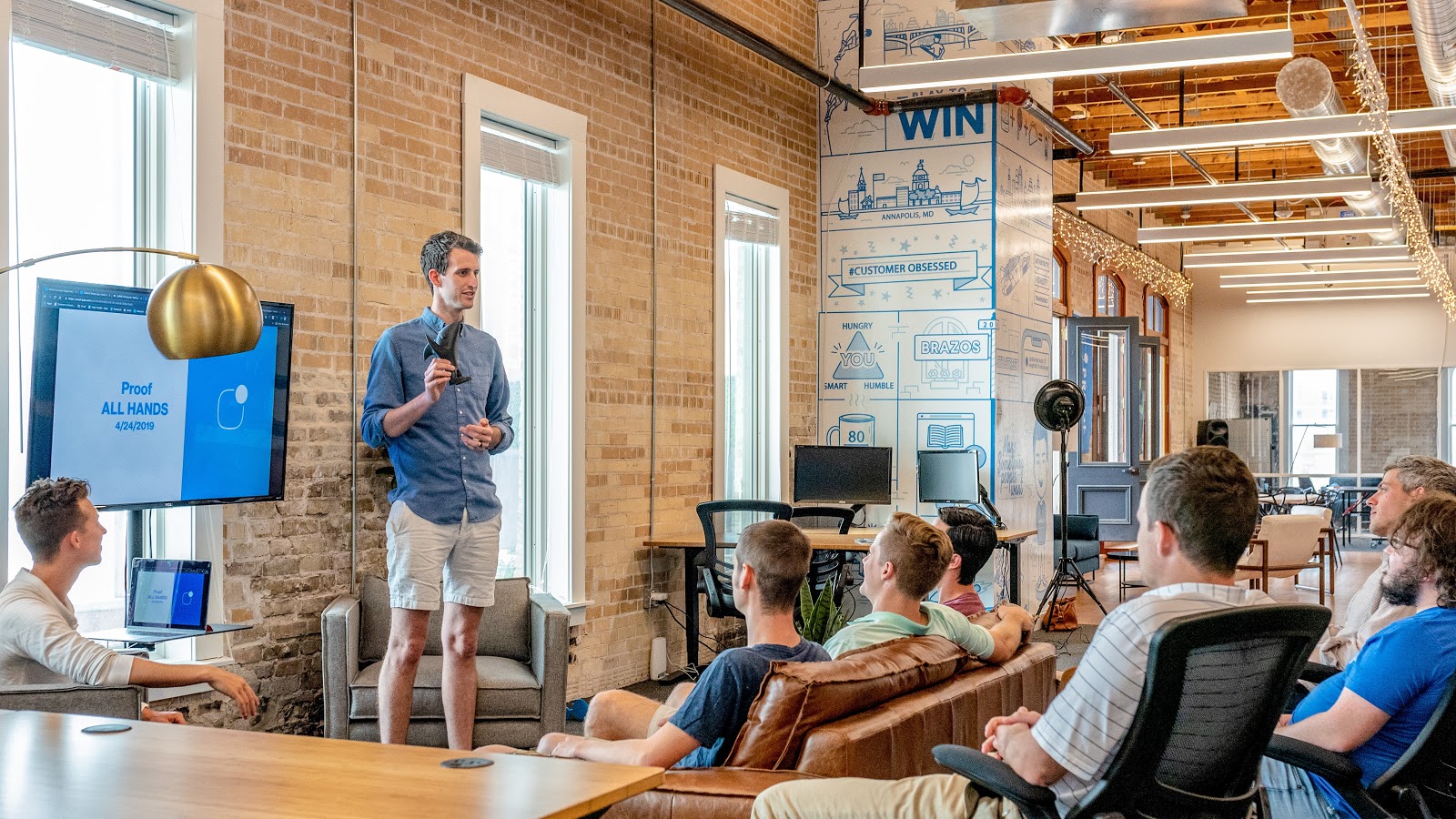
Simon Jenner
Thursday 7 January 2021

History of Presentation and its development.
Posted in:
Startups
If we were to ask you right now what your go-to digital presentation tool is, you’d probably answer with PowerPoint. Okay, okay - maybe if you’re a Mac user, your answer would be Keynote, or perhaps you’re a Prezi person, but you’d likely say one of these few options.
But these programs didn’t always exist. So what did presenters use prior to the introduction of PowerPoint in 1987?
Let’s take a step back from your habitual tendencies and explore the evolution of presentations and how this history is shaping no-code evolution and website creation.
Pre-Digital Presentations
We’ll begin all the way back in ancient times.
Even when digital tools, no-code, and building MVPs for startups weren’t yet a spec on the horizon, individuals found ways to use visual tools to tell stories. The first known version of these were Neanderthal cave paintings used for telling stories and passing them through the generations. Hundreds of years later, the middle ages were defined by monumental stained glass windows that often depicted religious stories.
Next came chalkboards and whiteboards. These tools were initially utilised for education, though eventually became integrated into businesses. Chalkboards and whiteboards are still a favourite among scientists and mathematicians presenting their findings.
Another form of analogue presentations that were often utilised pre-PowerPoint were poster cards and flip charts made from paper. Similar to chalkboards and whiteboards, these tools were most commonly used for educational purposes and in sales meetings as they were perfect for visual lessons.
Early Digital Presentations
Pre-digital tools were incredibly useful for their time, considering the available technology. However, by 1895, the first digital presentation tool emerged: a projector called The Magic Lantern.
This new tool was considered to be the most engaging and interactive form of presenting that individuals had witnessed to date. Projectors continued to develop rapidly alongside electricity throughout the 1900s.
Projectors also paved the way for filmstrips - 35mm film negatives that could be projected either by a filmstrip machine or on a wall, and were often used in education.
Meanwhile, slide design emerged. These were first placed as opening and ending credits in movies then later as informational material in the 1960s and 1970s, and were typically a simple combination of text and image. Much like non-technical founders utilising no-code today, many teachers began to create their own slides. It wasn’t until 1965 that slide design became more sophisticated through introduction of the Kodak Carousel.
Modern Digital Presentations
Of course, with technology beginning to advance later in the 20th century, presentation styles followed suit.
PowerPoint was introduced in 1987, creating a new platform for slide designers to create their slides in a faster and more expansive way. PowerPoint was initially designed for Apple computers in black and white, though Microsoft acquired the software months later and launched a colour version with pre-made templates, offering a similar experience as those templates offered today by no-code platforms, relative to the technology of their respective times.
In association with PowerPoint, a defining feature of the 1990s was Clip Art. It was evident even from the cave paintings from prehistoric times that presentations thrived off of visuals - therefore PowerPoint was in need of this capability as well.
Today, PowerPoint has outgrown ClipArt, though is a rather common digital tool in the average classroom or office. Additionally, more interactive tools like Prezi have emerged. We’ve seen a similar trend within the history of no-code, which has grown from simple Microsoft Excel functions to offering incredibly interactive and engaging features and widgets for website and app creation.
Imagine you were alive during the early 1900s. Would you have been innovative and adopted projector slide design? If the answer is yes, or even if you’d like to play an active role in the development of no-code by adopting it to build an MVP for your startup, snag your spot in our No-Code Bootcamp. We are just as excited as you are to be a part of the No-Code Revolution.
But these programs didn’t always exist. So what did presenters use prior to the introduction of PowerPoint in 1987?
Let’s take a step back from your habitual tendencies and explore the evolution of presentations and how this history is shaping no-code evolution and website creation.
Pre-Digital Presentations
We’ll begin all the way back in ancient times.
Even when digital tools, no-code, and building MVPs for startups weren’t yet a spec on the horizon, individuals found ways to use visual tools to tell stories. The first known version of these were Neanderthal cave paintings used for telling stories and passing them through the generations. Hundreds of years later, the middle ages were defined by monumental stained glass windows that often depicted religious stories.
Next came chalkboards and whiteboards. These tools were initially utilised for education, though eventually became integrated into businesses. Chalkboards and whiteboards are still a favourite among scientists and mathematicians presenting their findings.
Another form of analogue presentations that were often utilised pre-PowerPoint were poster cards and flip charts made from paper. Similar to chalkboards and whiteboards, these tools were most commonly used for educational purposes and in sales meetings as they were perfect for visual lessons.
Early Digital Presentations
Pre-digital tools were incredibly useful for their time, considering the available technology. However, by 1895, the first digital presentation tool emerged: a projector called The Magic Lantern.
This new tool was considered to be the most engaging and interactive form of presenting that individuals had witnessed to date. Projectors continued to develop rapidly alongside electricity throughout the 1900s.
Projectors also paved the way for filmstrips - 35mm film negatives that could be projected either by a filmstrip machine or on a wall, and were often used in education.
Meanwhile, slide design emerged. These were first placed as opening and ending credits in movies then later as informational material in the 1960s and 1970s, and were typically a simple combination of text and image. Much like non-technical founders utilising no-code today, many teachers began to create their own slides. It wasn’t until 1965 that slide design became more sophisticated through introduction of the Kodak Carousel.
Modern Digital Presentations
Of course, with technology beginning to advance later in the 20th century, presentation styles followed suit.
PowerPoint was introduced in 1987, creating a new platform for slide designers to create their slides in a faster and more expansive way. PowerPoint was initially designed for Apple computers in black and white, though Microsoft acquired the software months later and launched a colour version with pre-made templates, offering a similar experience as those templates offered today by no-code platforms, relative to the technology of their respective times.
In association with PowerPoint, a defining feature of the 1990s was Clip Art. It was evident even from the cave paintings from prehistoric times that presentations thrived off of visuals - therefore PowerPoint was in need of this capability as well.
Today, PowerPoint has outgrown ClipArt, though is a rather common digital tool in the average classroom or office. Additionally, more interactive tools like Prezi have emerged. We’ve seen a similar trend within the history of no-code, which has grown from simple Microsoft Excel functions to offering incredibly interactive and engaging features and widgets for website and app creation.
Imagine you were alive during the early 1900s. Would you have been innovative and adopted projector slide design? If the answer is yes, or even if you’d like to play an active role in the development of no-code by adopting it to build an MVP for your startup, snag your spot in our No-Code Bootcamp. We are just as excited as you are to be a part of the No-Code Revolution.
Ready to launch your startup idea with an MVP?
Download our step by step guide for non-technical founders to create a startup Minimum Viable Product (MVP)
Get the eBook

